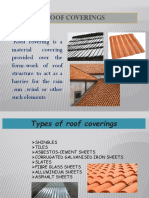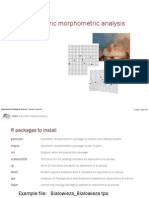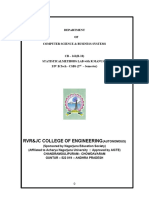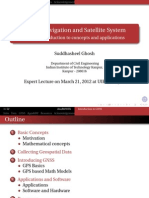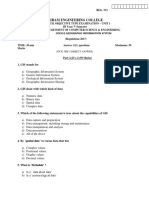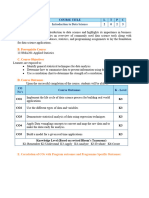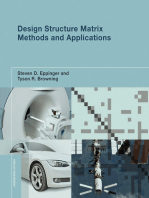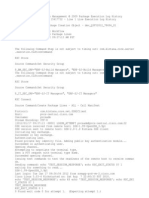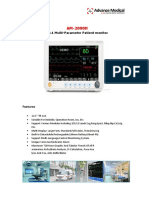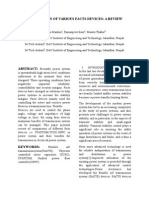Day 2B - Geometric Morphometrics in R PDF
Day 2B - Geometric Morphometrics in R PDF
Uploaded by
jackinthebox252Copyright:
Available Formats
Day 2B - Geometric Morphometrics in R PDF
Day 2B - Geometric Morphometrics in R PDF
Uploaded by
jackinthebox252Original Description:
Original Title
Copyright
Available Formats
Share this document
Did you find this document useful?
Is this content inappropriate?
Copyright:
Available Formats
Day 2B - Geometric Morphometrics in R PDF
Day 2B - Geometric Morphometrics in R PDF
Uploaded by
jackinthebox252Copyright:
Available Formats
G562 Geometric Morphometrics
A basic geometric morphometric analysis
Step by step in R
Department of Geological Sciences | Indiana University
(c) 2012, P. David Polly
G562 Geometric Morphometrics
R packages to install
geomorph shapes svd scatterplot3d rgl MASS ape vegan Geometric morphometrics package by Adams and Otrola-Castillo Geometric morphometrics package by Ian Dryden Singular value decomposition package Functions for 3D plotting (installed as dependency to above) More 3D functions (installed as dependency to above) Modern Applied Statistics with S (installed as dependency to above) Analyses of Phylogenetics and Evolution (installed as dependency to above) Community ecology package (installed as dependency to above)
Example file: Bialowieza_Bialowieza.tps Install from CRAN Load with library(packagename)
Department of Geological Sciences | Indiana University
(c) 2012, P. David Polly
G562 Geometric Morphometrics
General Procedure
Study design Data collection Data standardization Analysis Results interpretation
Department of Geological Sciences | Indiana University
(c) 2012, P. David Polly
G562 Geometric Morphometrics
Steps in a geometric morphometric analysis
1. Obtain landmark coordinates. 2. Standarization: Procrustes superimposition of the landmarks. removes size, translation, and rotation (also project to tangent space for further statistical analysis). 3. Standardization: Create shape variables (variables that retain information about shape, but are uncorrelated with one another and have appropriate degrees of freedom) PCA scores are one kind of shape variable that satisfy these requirements 4. Analysis: Conduct further analyses on the shape variables Type of analysis required depends on questions being addressed Regression, ANOVA, path analysis, tree-building, etc.
Department of Geological Sciences | Indiana University
(c) 2012, P. David Polly
G562 Geometric Morphometrics
Choosing landmarks
1. landmarks should sample the aspects of the shape that are of interest 2. enough landmarks should be used to adequately sample the shape 3. dont oversample (NB: each landmark adds weight to the
analysis. Multiple landmarks on one area will increase weight of that area.)
4. landmarks should be repeatable (same point on every specimen, placed with as little error as possible)
1. type 1 = location of the point defined by obvious biologically homologous structures (eg. intersection of three bones) 2. type 2 = location of the point defined by obvious geometry (eg., point of greatest curvature) 3. type 3 = location of point defined with reference to another point (eg., point ventral to last tooth)
Department of Geological Sciences | Indiana University
(c) 2012, P. David Polly
5. landmarks must be placed in the same order on all specimens
G562 Geometric Morphometrics
Obtaining landmark coordinates
From a file lands <- readland.tps(file.choose()) lands <- readland.nts(file.choose()) [imports from TPS format file] [imports from NTS format file]
From an image digitize2d(filename, landmarks, scale) [opens jpg file and collects lands]
Note: digitize2d may need debugging. Saves coordinates to file in working directory in NTS format.
readmulti.nts(filenames)
Department of Geological Sciences | Indiana University
(c) 2012, P. David Polly
Department of Geological Sciences | Indiana University
(c) 2012, P. David Polly
digitize2d()
Erik Otarola-Castillo has sent a fix. Do the following and the function will work: 1. Set the working directory to where your images are stored. 2. Define the function picscale() as follows
picscale <- function(scale){ digscale<-NULL digscale<-locator(2,type="o",lwd=2,col="red",lty="11") sqrt(sum(diff(digscale$x)^2 + diff(digscale$y)^2))*scale }
To collection landmarks in digitize2d:
1. If you have a scale bar in the images
1.1. enter the length of the scale bar as argument (e.g., 10 if the scale bar is 10 mm) 1.2. when digitize2d starts, click on both ends of the scale bar, then click on your landmarks in the proper order 1.3. coordinates and centroid sizes will be scaled in the units of your scale bar (e.g., mm)
2. If you dont have a scale bar:
2.1. enter 1 as the scale argument 2.2. when digitize2d starts, click in two arbitrary but different places on the image, then click on your landmarks in the proper order 2.3. coordinates will have no real units and centroid size will be meaningless
G562 Geometric Morphometrics
Automate the digitizing and loading of files
Digitize.My.Files <- edit()
function(path, lands, scale) { setwd(path) myFiles <- dir(pattern="[jJ][pP][gG]") for( i in 1:length( myFiles ) ) { dig2d(myFiles[i],lands, scale) } myFiles <- dir(pattern="[nN][tT][sS]") return(readmulti.nts(myFiles)) }
mylands <- Digitize.My.Files(/Users/pdavidpolly/ShrewsAndMarmots, 10, 10)
Department of Geological Sciences | Indiana University
(c) 2012, P. David Polly
G562 Geometric Morphometrics
Cryptic error?
Error in .External2(C_edit, name, file, title, editor) : unexpected input occurred on line 3 use a command like x <- edit() to recover
May be caused by smart quotes if you copied and pasted script from Word or other text editor
Department of Geological Sciences | Indiana University
(c) 2012, P. David Polly
G562 Geometric Morphometrics
Performing Procrustes analysis and obtaining shape variables
Also known as Generalized Procrustes Analysis (GPA) > gpa.lands <- gpagen(lands) results of gpagen() include:
1. a plot of the superimposed specimens and their consensus (mean) shape 2. superimposed coordinates ($coords) 3. shape variables as principal components scores ($pc.scores)
Department of Geological Sciences | Indiana University
(c) 2012, P. David Polly
G562 Geometric Morphometrics
Procrustes of shrew teeth
data from Bialowieza_Bialowieza.tps
Before
After
> plotAllSpecimens(lands)
Department of Geological Sciences | Indiana University
> gpagen(lands)
(c) 2012, P. David Polly
G562 Geometric Morphometrics
Details of gpagen()
proc <- gpagen(
This function does a generalized Procrustes analysis, superimposition of multiple specimens about their mean (Gower, 1975; Rohlf and Slice, 1990) Returns a plot of superimposed coordinates Returns the superimposed coordinates and their centroid sizes in dataframe format:
$coords = the x,y(,z) Procrustes coordinates after superimposition $Csize = the centroid size of the specimens
To plot the Procrustes coordinates yourself:
for(i in 1:dim(proc$coords)[3]) points(proc$coords[,,i]) plotAllSpecimens(proc$coords)
Department of Geological Sciences | Indiana University
(c) 2012, P. David Polly
G562 Geometric Morphometrics
Creating a principal components plot
> pca.lands <- plotTangentSpace(proc$coords, label=TRUE) results of plotTangentSpace() include: 1. a plot of the specimens in principal components space and two thin plate spline grids showing the shapes associated with the positive and negative ends of the horizontal axis (default = PC1 x PC2 set axes using the args axis1 and axis2) 2. summary of variance associated with each PC axis ($pc.summary) 3. shape variables as principal components scores ($pc.scores)
Department of Geological Sciences | Indiana University
(c) 2012, P. David Polly
G562 Geometric Morphometrics
Principal component plot of shrew teeth
Thin plate spline grid of shape at negative end of 1st axis
PC 2
Thin plate spline grid of shape at positive end of 1st axis PC 1
Department of Geological Sciences | Indiana University
(c) 2012, P. David Polly
G562 Geometric Morphometrics
Variance explained by PC axes
pca.lands$pc.summary
Department of Geological Sciences | Indiana University
(c) 2012, P. David Polly
G562 Geometric Morphometrics
Important concept: variance of a data set
Variance = variability = shape variation PC scores preserve the shape variation in the original data Variance = average squared distance from the mean Variance in Procrustes coordinates = Variance in PC scores
> sum(pca.lands$pc.summary$sdev^2) > sum(apply(pca.lands$pc.scores, 2, var)) > sum(apply(proc$coords,c(1,2),var))
Department of Geological Sciences | Indiana University
(c) 2012, P. David Polly
G562 Geometric Morphometrics
Show scree plot of variance explained
barplot(pca.lands$pc.summary$sdev^2/sum(pca.lands$pc.summary$sdev^2))
Department of Geological Sciences | Indiana University
(c) 2012, P. David Polly
G562 Geometric Morphometrics
Create your own customized plot
> plot(pca.lands$pc.scores[,1:2],pch=15,xlab="PC1",ylab="PC2") > text(pca.lands$pc.scores[,1:2],rownames(pca.lands$pc.scores[,1:2]),pos=4,cex=.5)
Department of Geological Sciences | Indiana University
(c) 2012, P. David Polly
G562 Geometric Morphometrics
Create 3D scatterplot
> library(scatterplot3d) > scatterplot3d(pca.lands$pc.scores[,1:3])
Department of Geological Sciences | Indiana University
(c) 2012, P. David Polly
G562 Geometric Morphometrics
Terminology: shape
Shape = a set of landmarks Sometimes shape specifically refers to the landmark configurations without respect to size and form refers to the configurations including size
Department of Geological Sciences | Indiana University
(c) 2012, P. David Polly
G562 Geometric Morphometrics
Terminology: Consensus shape
Consensus shape = mean shape Average x,y coordinate of each landmark after Procrustes alignment
To calculate
> consensus <- apply(proc$coords, c(1,2), mean)
> plot(consensus,asp=1, type="n") > for(i in 1:length(proc$coords[,,3])) points(proc$coords[,,i]) > points(consensus, col=Red, cex=2, pch=20)
Department of Geological Sciences | Indiana University
(c) 2012, P. David Polly
G562 Geometric Morphometrics
Terminology: centroid
The mean (center) of a shape (or of a landmark). Average x,y of all coordinates across all landmarks. (for individual landmark, the centroid is the consensus point for that landmark). To calculate:
> centroid <- apply(proc$coords,2,mean)
Department of Geological Sciences | Indiana University
(c) 2012, P. David Polly
G562 Geometric Morphometrics
Finding your way around shape space
150
Scores on PC1 and PC2 for first specimen
100
Position of consensus shape
[-67.3,0.77]
Squirrel Squirrel Mouse Shrew Shrew
PC2
50
Scores on PC1 and PC2 for fourth specimen
-150 -100
-50
[40.2,-22.2]
-150
-100
-50
0 PC1
50
100
150
Department of Geological Sciences | Indiana University
(c) 2012, P. David Polly
G562 Geometric Morphometrics
Visualizing shapes: thin plate spline grids
Allows difference between two shapes to be compared as a grid of first being deformed into second. Usually differences are shown between real (or imaginary) specimens and the consensus shape.
> plotRefToTarget(consensus,proc $coords[,,1])
Department of Geological Sciences | Indiana University
(c) 2012, P. David Polly
G562 Geometric Morphometrics
Principles of shape space
1. PCA space = shape space 2. Every point in shape space corresponds to configuration of landmarks 3. By definition, the consensus (mean shape) lies at the origin (0,0) of the shape space 4. PC scores are the coordinates of the PCA plot (they are the addresses of the points in the shape space)
Department of Geological Sciences | Indiana University
(c) 2012, P. David Polly
G562 Geometric Morphometrics
Landmark Space (specimen space)
Two (or three) dimensional space (x, y, z) Numbers associated with space are the landmark coordinates Many points per specimen
Shape Space (PCA space)
Multidimensional space (nearly as many dimensions as there are landmarks x coordinates) Numbers are scores (addresses in PC space) One point per specimen
Department of Geological Sciences | Indiana University
(c) 2012, P. David Polly
G562 Geometric Morphometrics
Basic steps of shape analysis in R
Capture images digital camera, etc. Collect coordinates digitize2d(filename) Read coordinate files in NTS format readmulti.nts(filenames) Superimpose landmarks and do PCA gpagen(lands) View PCA results plotTangentSpace($coords) Look at shape differences plotRefToTarget(shape1, shape2)
Department of Geological Sciences | Indiana University
(c) 2012, P. David Polly
G562 Geometric Morphometrics
PCA of faces
Axis 2 -0.05 0.00
0.05
-0.10
-0.05 Axis 1
0.00
0.05
Department of Geological Sciences | Indiana University
(c) 2012, P. David Polly
G562 Geometric Morphometrics
0.10
Daniel2 Derek1 DavidP1 0.05 Silvia1
PC2
Andrew2 Thomasz2 Aidan1 Silvia2 DavidP2 Nadia1 DavidW2 Julietta1 Nadia2 DavidW1 Mark1 Julietta2 Neil2 Emily2Neil1 Emily1 Daniel1 Mark2 Derek2 Thomasz1 Stephanie1 Aidan2 Stephanie2
0.00
Andrew1 -0.05 -0.15
-0.10
-0.05 PC1
0.00
0.05
0.10
Department of Geological Sciences | Indiana University
(c) 2012, P. David Polly
G562 Geometric Morphometrics
0.10
Daniel2 Derek1 DavidP1 0.05 Silvia1
PC2
Andrew2 Thomasz2 Aidan1 Silvia2 DavidP2 Nadia1 DavidW2 Julietta1 Nadia2 DavidW1 Mark1 Julietta2 Neil2 Emily2Neil1 Emily1 Daniel1 Mark2 Derek2 Thomasz1 Stephanie1 Aidan2 Stephanie2
0.00
Andrew1 -0.05 -0.15
-0.10
-0.05 PC1
0.00
0.05
0.10
Department of Geological Sciences | Indiana University
(c) 2012, P. David Polly
You might also like
- NACE Corrosion Data Survey Metal Section 6th Ed Nace Publisher 1985Document206 pagesNACE Corrosion Data Survey Metal Section 6th Ed Nace Publisher 1985VIVEKNo ratings yet
- Lecture 1 - Introduction To Geometric MorphometricsDocument36 pagesLecture 1 - Introduction To Geometric MorphometricsFrancis PeritoNo ratings yet
- Roof CoveringsDocument25 pagesRoof CoveringsBhanu Pratap SinghNo ratings yet
- Geometric Morphometrics in RDocument30 pagesGeometric Morphometrics in RAndrés ChuraNo ratings yet
- Lecture 7 Bootstrapping, Randomization, 2B-PLSDocument19 pagesLecture 7 Bootstrapping, Randomization, 2B-PLSAngelo Emmanuel HoNo ratings yet
- Cb161 Lab ManualDocument25 pagesCb161 Lab Manualk.nagaraju.No ratings yet
- 8 - Cia 3 KeyDocument3 pages8 - Cia 3 KeyAshish ChowdartyNo ratings yet
- Expert Lecture On GPS at UIET, CSJMU KanpurDocument57 pagesExpert Lecture On GPS at UIET, CSJMU KanpurSuddhasheel Basabi GhoshNo ratings yet
- ANA Projects ListDocument44 pagesANA Projects ListRaul GarciaNo ratings yet
- International Journals Call For Paper HTTP://WWW - Iiste.org/journalsDocument25 pagesInternational Journals Call For Paper HTTP://WWW - Iiste.org/journalsAlexander DeckerNo ratings yet
- 2015jan Ggplot2koffmanDocument79 pages2015jan Ggplot2koffmanmindlinjasNo ratings yet
- Introduction To MATLAB: Biosystems Analysis and ModelingDocument4 pagesIntroduction To MATLAB: Biosystems Analysis and ModelingNealNo ratings yet
- Exam 2011 Data Mining Questions and AnswersDocument16 pagesExam 2011 Data Mining Questions and Answersdebmatra0% (1)
- THOMPSON Assignment 1Document9 pagesTHOMPSON Assignment 1Liam ThompsonNo ratings yet
- Reference Paper 5Document35 pagesReference Paper 5bharath5911No ratings yet
- Fern d2Document15 pagesFern d2api-252111068No ratings yet
- NullDocument202 pagesNullapi-27584557No ratings yet
- Eulers Method and Logisitic Growth - SOLUTIONSDocument5 pagesEulers Method and Logisitic Growth - SOLUTIONSAura Angélica LibertadNo ratings yet
- Ggplot2 IntroDocument78 pagesGgplot2 Introvinay kumarNo ratings yet
- COSC 6342"machine Learning" Homework1 Spring 2013Document9 pagesCOSC 6342"machine Learning" Homework1 Spring 2013Hanumantharayappa GjNo ratings yet
- 02 Concepts pt1Document85 pages02 Concepts pt1Thyago MirandaNo ratings yet
- Ce 531, GisDocument38 pagesCe 531, Gissagardatta2467No ratings yet
- MainDocument14 pagesMainHenry MarichalNo ratings yet
- Section 7.7 Transformation HellingerDocument7 pagesSection 7.7 Transformation HellingerMichelle Vanessa Soto AvendañoNo ratings yet
- Computational Statistics and Data Analysis: Stelios D. Georgiou, Stella Stylianou, Manohar AggarwalDocument10 pagesComputational Statistics and Data Analysis: Stelios D. Georgiou, Stella Stylianou, Manohar Aggarwal-No ratings yet
- Practical No 1 AimDocument17 pagesPractical No 1 AimPrachi BorlikarNo ratings yet
- Class-3 46Document8 pagesClass-3 46munmunnandy100% (1)
- Practical Journal Sna With WriteupsDocument37 pagesPractical Journal Sna With Writeupssakshi mishraNo ratings yet
- Coursework 5 - WebDocument16 pagesCoursework 5 - WeblddsdpNo ratings yet
- Ee5551 Newproj ReportDocument18 pagesEe5551 Newproj ReportPoornima BehlNo ratings yet
- Multi-Modal 2D and 3D Biometrics For Face RecognitionDocument8 pagesMulti-Modal 2D and 3D Biometrics For Face RecognitionIkram CheboutNo ratings yet
- Answer Key Points and SolutionsDocument10 pagesAnswer Key Points and SolutionsKunvar Sourabh SinghNo ratings yet
- P N Suganthan PDFDocument123 pagesP N Suganthan PDFsmprabu24317No ratings yet
- Space Frame DesignDocument8 pagesSpace Frame DesignffontanaNo ratings yet
- Examplers Based Image Fusion Features For Face RecognitionDocument13 pagesExamplers Based Image Fusion Features For Face RecognitiondanangkitaNo ratings yet
- Como Mexer No RDocument29 pagesComo Mexer No RBeatriz AlonsoNo ratings yet
- Cse 435 K_s_a Test 2 Set d Fall_2024Document2 pagesCse 435 K_s_a Test 2 Set d Fall_2024green212cse142No ratings yet
- Project2 2022 FallDocument7 pagesProject2 2022 Fallitsmymail429No ratings yet
- Wa0030.Document36 pagesWa0030.bvinnuroiroi467No ratings yet
- Forecasting With R Earth Temperature Mean Until 2025: by Majdi AwadDocument7 pagesForecasting With R Earth Temperature Mean Until 2025: by Majdi AwadMajdi AwadNo ratings yet
- Question and DiscussionDocument2 pagesQuestion and DiscussionHamierul Mohamad100% (1)
- ML Practical Journal With WriteupsDocument46 pagesML Practical Journal With Writeupssakshi mishraNo ratings yet
- Determination of The Sphericity of Granular Food MaterialsDocument7 pagesDetermination of The Sphericity of Granular Food MaterialssmendozaNo ratings yet
- Question 1Document3 pagesQuestion 1Mohanapriya KuppanNo ratings yet
- PostGIS INTRODocument58 pagesPostGIS INTROdr4sk0No ratings yet
- Legendre-Gallagher2001 Article EcologicallyMeaningfulTransfor PDFDocument10 pagesLegendre-Gallagher2001 Article EcologicallyMeaningfulTransfor PDFAna Carolina Martins PereiraNo ratings yet
- Distance Cartesian PlaneDocument63 pagesDistance Cartesian PlaneJorge U. TaguibaoNo ratings yet
- Characteristics of Fuzzy Petersen Graph and Platonic Graph With Fuzzy RuleDocument7 pagesCharacteristics of Fuzzy Petersen Graph and Platonic Graph With Fuzzy RuleIJRASETPublicationsNo ratings yet
- 03 Concepts pt2Document115 pages03 Concepts pt2Thyago MirandaNo ratings yet
- Introduction To R Software EnvironmentDocument6 pagesIntroduction To R Software EnvironmenthanyeelovesgodNo ratings yet
- Unit1 GisDocument5 pagesUnit1 GisVani RajasekharNo ratings yet
- 1152CS239-Intro. To Data Science-SyllabusDocument6 pages1152CS239-Intro. To Data Science-SyllabusShashitha ReddyNo ratings yet
- BIOMA EcoMod Zamuda Revised AngDocument11 pagesBIOMA EcoMod Zamuda Revised AngnofNo ratings yet
- Assessment of Circle Fitting Method From Different Thicknesses and Heights On DBH Estimation Using Terrestrial Laser Scanner DataDocument6 pagesAssessment of Circle Fitting Method From Different Thicknesses and Heights On DBH Estimation Using Terrestrial Laser Scanner DataGabriel YedayaNo ratings yet
- Synthesis of Four-Bar Linkage Motion Generation Using Optimization AlgorithmsDocument14 pagesSynthesis of Four-Bar Linkage Motion Generation Using Optimization AlgorithmsMario AcevedoNo ratings yet
- 348-Article Text-2157-1-18-20221025Document15 pages348-Article Text-2157-1-18-20221025Muhammad Rafif FajriNo ratings yet
- Introduction To GIS: Joey Li @joeyliccDocument12 pagesIntroduction To GIS: Joey Li @joeyliccJessica Gabriela Villatoro EscobarNo ratings yet
- Computational Geometry: Exploring Geometric Insights for Computer VisionFrom EverandComputational Geometry: Exploring Geometric Insights for Computer VisionNo ratings yet
- Design Structure Matrix Methods and ApplicationsFrom EverandDesign Structure Matrix Methods and ApplicationsRating: 5 out of 5 stars5/5 (2)
- ROHS LogDocument41 pagesROHS LogGanesh SatishNo ratings yet
- Nomenclature TexstudioDocument3 pagesNomenclature TexstudioogiraldNo ratings yet
- F10 Taps in Auto Transformers SlidesDocument42 pagesF10 Taps in Auto Transformers Slidesverma210100% (1)
- MD Nastran InputDocument24 pagesMD Nastran InputSameera SrivathsaNo ratings yet
- B16 Statics - Trusses - ProblemsDocument30 pagesB16 Statics - Trusses - ProblemsDiana Ayala ChungaNo ratings yet
- Chaotic Lorenz System: Analysis of The Main Information Properties, Circuit Realization and LED Visualization Using ArduinoDocument8 pagesChaotic Lorenz System: Analysis of The Main Information Properties, Circuit Realization and LED Visualization Using ArduinoRené Mboyo KouayepNo ratings yet
- Expt 8 Data Sheet - NewDocument3 pagesExpt 8 Data Sheet - NewSweetzeil TapiaNo ratings yet
- DSSLTC 4020Document42 pagesDSSLTC 4020cueNo ratings yet
- AgnesDocument25 pagesAgnesDyah Septi AndryaniNo ratings yet
- AM-2000H Patient Monitor (1765)Document7 pagesAM-2000H Patient Monitor (1765)Carlos TorralbaNo ratings yet
- Netsim For CCNA Lab ManualDocument175 pagesNetsim For CCNA Lab Manualparthasn83No ratings yet
- ICC-ES Evaluation Report ESR-3178: Schraubenwerk Gaisbach GMBH (SWG)Document13 pagesICC-ES Evaluation Report ESR-3178: Schraubenwerk Gaisbach GMBH (SWG)civiliiiNo ratings yet
- Workshop 1.1: Basics: Introduction To Ansys Spaceclaim Direct ModelerDocument11 pagesWorkshop 1.1: Basics: Introduction To Ansys Spaceclaim Direct ModelerTanishk KumarNo ratings yet
- An Introduction To Python For Absolute BeginnersDocument457 pagesAn Introduction To Python For Absolute BeginnersfidelkaeyNo ratings yet
- Section 6 - Combined Stresses PDFDocument133 pagesSection 6 - Combined Stresses PDFGlënnLibönTäbiölö100% (1)
- Hess S Law LabDocument9 pagesHess S Law LabMohammad IzadiNo ratings yet
- Ammonium Polyacryloyldimethyl TaurateDocument21 pagesAmmonium Polyacryloyldimethyl TaurateamaliahpNo ratings yet
- XII - Physics - Chapter 4 - Moving Charges - Magnetism - Saju - Hsslive PDFDocument15 pagesXII - Physics - Chapter 4 - Moving Charges - Magnetism - Saju - Hsslive PDFMariyam FarhanaNo ratings yet
- Facts Devices ComparisonDocument5 pagesFacts Devices ComparisonAmit Pratap SinghNo ratings yet
- Oracle Advanced Security Internals Demonstrating Network EncryptionDocument10 pagesOracle Advanced Security Internals Demonstrating Network EncryptionĐỗ Văn Tuyên100% (1)
- Design of Machine Members-I April 2019Document8 pagesDesign of Machine Members-I April 2019Uday NarasimhaNo ratings yet
- Pumps Rotary Gear Pump Selection GuideDocument1 pagePumps Rotary Gear Pump Selection GuidewidhisaputrawijayaNo ratings yet
- Unit 1 - MODULE 3 NOISE CALCULATIONSDocument29 pagesUnit 1 - MODULE 3 NOISE CALCULATIONSc1.2dummyNo ratings yet
- Catalogo OmronDocument71 pagesCatalogo OmronPaola NoMás DicenNo ratings yet
- Lecture 8 Cooling Frezzing DehydrationDocument26 pagesLecture 8 Cooling Frezzing DehydrationrupokistiyakNo ratings yet
- Pune Elce CompanyDocument6 pagesPune Elce Companymayur jabareNo ratings yet
- JOHN E. BRANDENBURG, VINCENT DIPIETRO - The Cydonian Hypothesis PDFDocument25 pagesJOHN E. BRANDENBURG, VINCENT DIPIETRO - The Cydonian Hypothesis PDFnexus100% (1)
- Apl Apollo Tubes Limited Unit-Iii: Test Certificate For Rhs and BLKDocument1 pageApl Apollo Tubes Limited Unit-Iii: Test Certificate For Rhs and BLKunsteelmumbaiNo ratings yet


